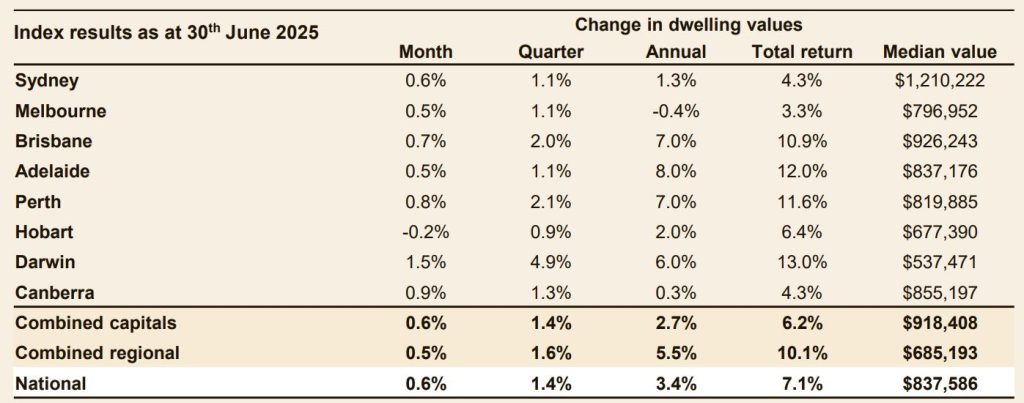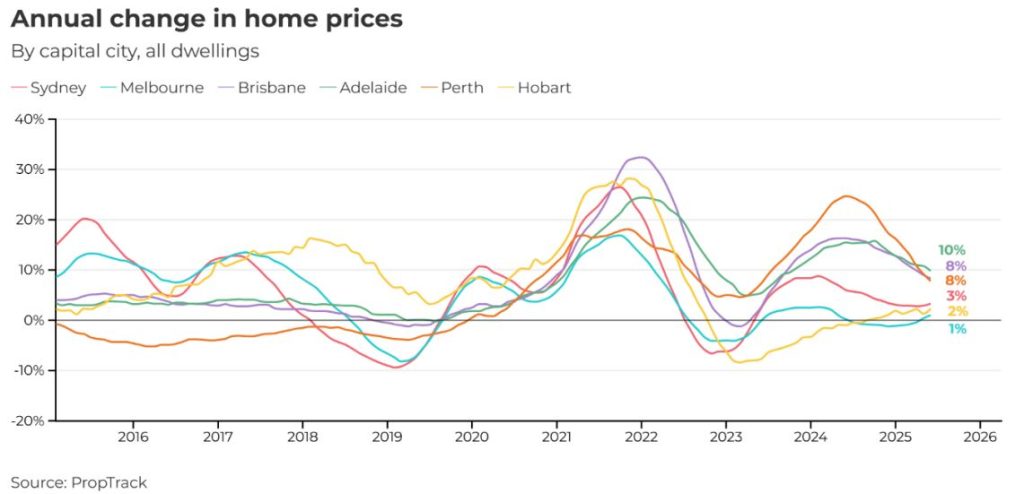The property market is showing signs of returning to high growth levels as interest rate reductions entice buyers previously unable to meet monthly repayment demands, but affordability constraints still weigh heavily.
A lack of advertised housing stock and declining interest rates have propelled property prices higher for a fifth successive month, with June’s 0.6 per cent capital growth narrowly eclipsing the 0.5 per cent of the previous month.
The acceleration in property prices was slightly stronger in the capital cities, but price growth is strong everywhere outside Tasmania.
Widespread speculation that the Perth property market had run out of steam is proving premature.
Although lagging Darwin’s resurgent market, the clear frontrunner with 1.5 per cent gains in June, and Canberra (0.9 per cent), Perth’s 0.8 per cent median dwelling value rise dispelled any sense that it was retreating any time soon.
The Cotality Home Value Index (HVI) for June showed that on an annual basis, Adelaide is leading the way with an 8.0 per cent surge in prices. Melbourne is the only city to record a price decline in that period (-0.4 per cent).
Tim Lawless, Research Director, Cotality, said the current housing rebound is occurring against a backdrop of relatively low home sales.
Housing turnover through the first half of the year, based on estimates of sales and total dwelling stock, is tracking at an annualised pace of 4.9 per cent, slightly below the decade-average turnover of 5.1 per cent.
From a supply perspective, advertised stock levels are also low, tracking -5.8 per cent below the same time a year ago (based on data for the four weeks ending June 29th) and -16.7 per cent below the previous five-year average.
“Although demonstrated demand is tracking slightly below average, advertised supply is scarce, creating a more balanced market for buyers and sellers,” Mr Lawless said.
“Improved selling conditions can be seen in auction clearance rates, which have risen to slightly above the decade average in the last two weeks of June, holding around the mid 60 per cent range.”
New home sales outperforming wider market
It’s a different story for new builds.
Monthly sales of new homes rose 6.9 per cent (in May), to reach the highest level in 13 months.
As with the wider market, descending interest rates were seen as the catalyst.
HIA Senior Economist, Maurice Tapang, said this rise in sales follows the second cut to the cash rate in over four years.
“The monthly increase in new home sales is consistent with demand factors remaining robust, as Australia records low levels of unemployment, strong population growth and rising prices for established homes.
“Across the states, the results have been mixed; this month, New South Wales and Victoria were the only states surveyed to report increased sales volumes, albeit from very depressed levels.
“Sales volumes in New South Wales and Victoria have been exceptionally weak over the past two years.
“This increase is the first suggestion of an improvement in market conditions in these states.”
Affordability pressures
If national property prices were to continue their current trajectory for the remainder of 2025, based on Cotality’s HVI, the resultant national annual growth rate of 5.8 per cent would be slightly above the decade average annual rate of 5.2 per cent.
Data also released Tuesday (1 July) by PropTrack, showed property prices to be a little less lively but still solidly in positive territory.
By their metrics, national home prices rose 0.4 per cent in June, marking a new record high. Prices are now 4.6 per cent higher than a year ago.
Capital city markets drove the gains, with prices up 0.4 per cent month-on-month.
Adelaide posted the strongest monthly rise (0.6 per cent), extending its streak of outperformance and retaining its title as the strongest performing capital city over the past year (9.8 per cent).
Eleanor Creagh, REA Group’s Senior Economist, said that as interest rates have fallen, price momentum has strengthened and extended across the country.
“Market momentum is building amid renewed buyer confidence and improved sentiment, buoyed by falling interest rates and expectations of another rate cut in July, however, the upturn remains measured as affordability constraints keep the pace of growth in check.
“In addition, population growth and limited new supply are also placing upward pressure on prices, especially at the more affordable end of the market.
“With interest rates moving lower, these factors are likely to sustain price growth over the second half of 2025.
“Despite these tailwinds, the upturn remains gradual and stretched affordability will see a more measured upswing than in previous easing cycles.”
Mr Lawless echoed that sentiment, saying that despite the prospect for lower interest rates, “affordability constraints will likely temper the extent of a housing market upswing.”






